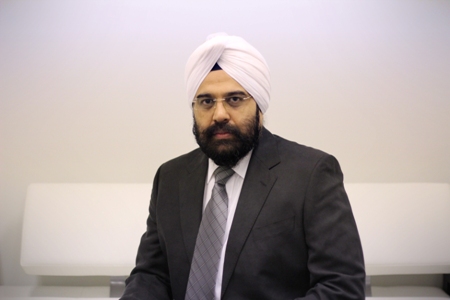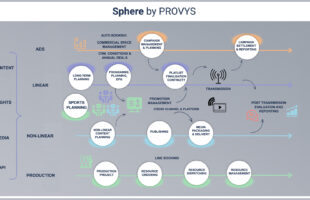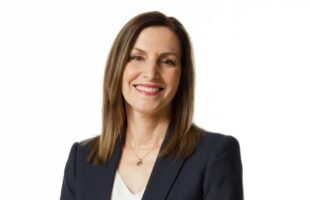
Encompass Digital Media Asia recently achieved a new broadcast milestone by originating and transmitting 100 channels from its Singapore facility. With a client base that includes AETN All Asia Networks, AMC, BBC Worldwide, BBC, CNBC, Discovery Communications, FOX, LiTV, MTV Networks, Scripps Networks, Sony Asia, Tata Communications and Tigergate, to name a few, Encompass Asia commands more than 30% share in the market.
In Singapore, the company has the largest digital media facility in the region from where content is played out to the rest of Asia, reaching as far as South Korea, Japan, New Zealand and India. In an interview with TV ASIA Plus, Deepakjit Singh, Managing Director, Asia, Encompass Digital Media, discusses this achievement, its significance, the challenges in getting to this milestone, and some of the investments that the company has been doing to further strengthen its presence in Asia.
Deepakjit Singh, Managing Director, Asia, Encompass Digital Media
Q: 100 channels: what is the significance of hitting this mark?
A: One hundred (channels) means a lot in the industry, because as far as we know, there’s no other third party playout centre in Asia who’s doing something like 100 channels. The competition is way behind, so playing out 100 channels is a big achievement. Even for our partners, our vendors, everybody else who has been supporting us all the way. That’s the reason it’s an important thing for us.
So when we reached 100, we thought we should stabilize everything else. It has been an overall growth, not just the channels and playouts and playing all the stuff here. It’s been coming into new technology and coming into new media, getting into the IP domains, multi-screen and multi viewers. That’s where we stand; we have increased our base.
Q: As you launch your 100th channel here in Singapore, what are some of the issues that come with the growing reservoir of content?
A: In my experience, there are three phases of growth. The first phase is when you are small and you can grow. Percentage-wise, you’re growing fast but you don’t need a structure to grow to a particular part. Then the second phase of the growth comes when you need a structure, when you need a lot of infrastructural support to grow beyond it.
About a year and a half ago, I said we are growing, but we are reaching a point where we need a lot of infrastructural support on toward, like fibre. Fibre connectivity into the facilities is so critical that we actually have multiple diversities coming into the facility. For us, power and fibre are the two main things for our lives. If either one of those two breaks, we panic. It’s a real crisis for us.
For the power side, Singapore is good. We can get power from two different power suppliers into our facility. So it’s totally redundant. Similarly for fibre, we have the SingTel fibre, the Telstra fibre; if we take the dark fibre, we’ve got gigabytes of fibre coming into the facility. I don’t think there’s any other place with that sort of bandwidth going in. We transmit between fibre and satellite around 52.5 million minutes of television every year. Once you start to begin to see those numbers, that’s when it starts to make one realize how much important it is to the connectivity. We have also gone to the next phase now.
From linear television we now go on to what is called the multi-screens. In my opinion, the industry will have to, at some stage, accept it. For a consumer, it doesn’t matter whether you’re doing it on the hand phone, or an iPad or a mini iPad or on the big screen or on the television screen or in a studio screen. It is just the size of the screen. A person would want that when he’s sitting in a meeting, he should be able to watch the same thing on his iPhone or other smartphone that has a 4-inch screen. When he gets into his car or when he gets into the MRT (local subway), he should be able to do it on a 7-inch screen. When he gets home, he should be able to do it on a 24-inch screen. If he’s in his study or in his lounge with his family, he should be able to do it on a 56-inch or 60-inch screen. You want the same experience from a 4-inch to a 72-inch screen.
We are getting into a point that we want to seamlessly get into one screen on to another. I don’t really want to say, “Oh I have watched until this point; now I go on to my television screen and watch it in a different thing.” I think that we are still doing it only because we have not reached that level of technology. Our next task is reaching that sort of consumer satisfaction. How can we give our business, channels, everybody else or my customers, a technology so that they can provide to a consumer?
Q: What do you think are the key issues that are limiting the growth towards that future?
A: I am of a firm opinion that one is always limited by one’s own ambitions. As a consumer, we have not started to demand for it. When we demand it, the industry will have to give it. It is always that way.
So as a consumer, when we start to create enough momentum towards an experience that we want, technology will be merely an instrument. It doesn’t really take long for the technology to develop. As soon as there are volumes, every technology in the world will provide it.
Q: Can you share how Encompass’ infrastructure is strengthening its capacity?
A: We have nearly doubled our fibre capacity since the beginning of 2012. We have dark fibre coming into our facility now, and we have multiple fibre routes from SingTel, StarHub and Telstra into our route. The problem that we have, and this is absolute realistic problem, is growth – which I always think is a good problem.
But just when we thought we have increased the capacity very dramatically, the utilisation very quickly catches up. That’s when we realised that the consumer demand has started to come for IPTV or the streaming of content on the IP. Now that jacks up for us a lot of bandwidth. What that has led to is (our plan for) the next phase of expansion. In the next fiscal year, both our fibre capacity and the connectivity into the facility would double from what we have. On the monitoring stations and all that, we are now getting more automated. We’ve just invested in a technology to increase productivity.
So if you take the last one year or the last 15-16 months, we have invested heavily in that. In 2011, we announced that we’ll be investing S$20 million over the next five years into the Singapore operations for technology and infrastructure upgrading, employee up-skilling and community engagement initiatives. To date, Encompass Asia have already invested close to US$10 million on technology upgrading in order to increase productivity and reduce the marginal cost of launching a new channel. This enables Singapore to compete effectively with China and India.
In less than one third of that period, we’ve already done more than half of that amount of investment. That increases the productivity and that increases our margin, our ability to stay in Singapore and expand in Singapore.
On power, we’ve began major expansion on the power upgrade – you have to invest in the UPS and the generators and everything else. Any day you walk into our facility, there’s so much work going on in the power and the fibre that sometimes it amazes us.
Also, we have increased our digital storage capacity. We are touching around 7.6 to 8 petabytes of digital storage in our facility. That’s another area where we have increased the capacity in.
Q: What about the content? Broadcasters and content providers now tend to deliver HD content. What about legacy content in SD?
A: This issue’s addressed at two different levels. One is the content level, one is the infrastructure level. If you address it at these two levels then you can always address it to the consumer level, that’s the playout or distribution level. In our experience, majority of the content today is coming in HD. I would say around 70% plus is coming on HD and around 60-70% is coming in a digital format; it’s not coming in tapes anymore. Two years ago, it was the other way around.
As far as the infrastructure is concerned, we do not buy anything that is not HD, unless it is so specific for a particular customer. You can never be 100%. As a principle, unless we have to do it, we don’t make any purchase of any equipment that is SD only. We do it with HD. That’s basic. We only buy equipment in SD if it is field-upgradable to HD, but gradually, we’re converting everything into facility into HD.
Now what happens to the content that comes in SD? What we are trying to do is, if we get something in SD, we see whether we can get an HD source of it or if we can up-convert it into HD. Our philosophy as of now is everything should be HD; if it is SD, then it is demarcated. Even to broadcasters who are not broadcasting HD into the consumers, we actually play it out in HD, and before it goes to the consumer, or uplink or on the fibre or the satellite, it is downconverted to SD. Practically for everything, we do HD.
I think we should be seeing in the next couple of years that hardly any channel will be in SD. You really go on with the last mile bandwidth now or the satellite bandwidth now. The new channels we are launching have more HD channels than SD channels. As the years will pass, only legacy content will be in SD.
Q: How has “languaging” requirements evolved and how’re you meeting those requirements?
A: I’ll address this requirement on a few levels. One is languaging that is in the voice, the audio languaging, and one is subtitle. Subtitle is much simpler to handle. In languaging, whether anybody likes it or not, you have to focus on the Asian consumers if you want to be n Asia.
The first area where people have addressed – and they have seen that they can’t live without it – is subtitles. So we are doing a multiple subtitle broadcast. The same programme is going with eight different subtitles – depending on which country is getting the feed. A similar trend is coming on the audio languaging. It is a trend that is growing – (having) multiple audio languages on the same video. This market in the languaging segment is bound to grow leaps and bounds within next 12 to 20 months.
It is becoming more competitive to get into multiple languages and the voice talent is not really that much there at the moment, but that’s a new area of talent that is emerging. From our point of view, we are not getting into languaging as such but as an infrastructure provider, we are getting into providing the languaging booths. You don’t really require a big studio to do the languaging, you will have a screen and you will have soundproof players where you can actually do re-runs, slow-run, script run and all that is required in languaging.
Another particular area which will give a big flip to languaging is if 3D picks up. Subtitling in 3D is a big task. At what level do you subtitle – in front or subtitling in the depth; and how do you get the depth and all that?
Q: What new trends and latest requirements from the clients will lead you to implement different approaches when transmitting content from your partners to different markets in Asia?
A: One of the trends that is absolute definite and is coming, in which we have seen in the last couple of months, is what we call the localisation of channels. You would have seen that on StarHub and SingTel mio TV. That’s a trend that is unstoppable and is going to happen. What that means is people will have to stop thinking of Asia as a single market. It is not. What you advertise in Japan or in Taiwan is of no use in the Singapore market. The percentage of people who can understand that is very little. So the localisation is going to happen. At the same time, the clients or the broadcasters or the content owners, they have to get into how you localise a channel at a much lower cost.
We are already into it, in what we call “ad inserts” or “mini playout”. This means we take a content or broadcast channel that is coming in a pan-Asian feed or a pan-global feed, and then convert it into a localised feed. You’re not really doing all that asset management but you’re really localising a certain portion of it. So the number of hours you’re inserting the local advertisements and then sending it to the specific service providers. That’s a big trend that is coming, and that has to be very cost-effective because the revenue being earned from a localised market is also much less. No longer can you afford big set-ups for localisation. We are at a point where we can actually offer this to the customers. That is the next wave that we are going to ramp on.









